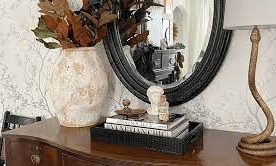The Gothic style is an architectural and interior design trend that dates back to the medieval period. It features dark, dramatic colors, ornate details, and bold patterns. If you want to create a Gothic living room, here are some tips to help you get started.
Choose Your Color Scheme
Gothic style is characterized by rich, dark colors like deep reds, purples, and blacks. You can incorporate these colors into your living room through your walls, furniture, and decor.
Consider painting your walls a dark color like burgundy or navy blue to create a dramatic backdrop for your furniture and decor. You can also choose furniture in dark colors or patterns, such as a black velvet couch or a patterned chair with dark red upholstery.
Incorporate Ornate Details
Gothic style is known for its ornate details, so look for furniture and decor with intricate designs and details. Look for pieces with carved wood, intricate metalwork, or ornate upholstery.
Consider adding a Gothic-style chandelier to your living room to create a dramatic focal point. You can also incorporate decorative accessories like candlesticks, candelabras, or antique mirrors with ornate frames.
Add Texture
The texture is an important element in Gothic design. Look for fabrics like velvet, silk, or brocade to add richness and depth to your living room. You can incorporate texture through your upholstery, curtains, or decorative pillows.
Consider adding a plush area rug to your living room to create a cozy and inviting space. Look for rugs with bold patterns or dark colors to match the Gothic theme.
Use Gothic-Inspired Decor
There are many Gothic-inspired decor items that you can add to your living room to enhance the overall theme. Consider adding Gothic-style artwork, such as portraits, landscapes, or still lifes.
You can also incorporate Gothic-inspired decorative objects like skulls, candles, and antique books. Look for antique or vintage pieces that fit the Gothic aesthetic, such as an old typewriter, a vintage clock, or an antique globe.
Focus on the Details
Small details can make a big difference in a Gothic living room. Look for decorative elements like tassels, fringes, or braided cords on your furniture or curtains. You can also add decorative trim to your upholstery or throw pillows.
Consider adding Gothic-style hardware to your furniture, such as drawer pulls or cabinet knobs with intricate designs. You can also add decorative tassels to your lampshades or curtains to add a touch of elegance.
Consider the Lighting
Lighting is an important element in any room, but it’s especially important in a Gothic living room. Look for lighting fixtures that fit the Gothic aesthetic, such as chandeliers, sconces, or floor lamps with ornate designs.
Consider using candles or lanterns to create a warm, intimate atmosphere in your living room. You can also add decorative candleholders to your tabletops or mantel for added visual interest.
Don’t Forget the Accents
Accents can add a finishing touch to your Gothic living room. Look for decorative items like figurines, vases, or decorative boxes to add interest to your tabletops or shelves.
Consider adding a Gothic-style clock to your living room to add a touch of old-world charm. You can also add decorative accents like feathers, dried flowers, or branches to create a natural, organic feel.
Conclusion
Creating a Gothic living room can be a fun and exciting project. By incorporating these tips, you can create a dramatic, elegant space that reflects your personal style and interests. Remember to choose your color scheme, incorporate ornate details, and focus on the small details to create a cohesive and visually stunning room.

